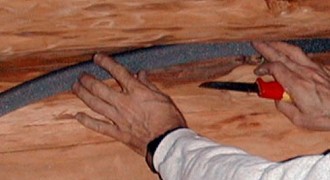Rigid polyethylene sealing strip
A low-priced, but nevertheless effective sealing strip known as the name Backer Rod below. It remains visible between the logs and is a chemically neutral rigid polyurethane "rope" that is made to effectively fill the gaps between the logs before sealing agents are applied. Perma-Chink or Energy Seal application.
Backer Rod is flexible and easy to push into the opening, it fits well with all possible angles of the log. The main task of the sealing strip is to fill the free opening between the log and the sealing wax. Choose the appropriate thickness of sealing strip that best fits the gap between the logs.
For example, a sealing strip with a centimeter diameter should be used in a log gap that is about 2.5 cm wide (about 15 cm for a log). Place the sealing strip between the logs, observe the placement of the ends of the sealing strip.
Trap Rod the sealing strip is used for log houses, where the log gaps are filled with elastomeric sealing wax. Trap Rod sealing strip reduces the required Perma-Chink amount of sealant, but fills the log gaps properly. Perma-Chink does not stick Trap Rod on the sealing strip, but only on the surface of the logs.
Match Trap Rod sealing strip carefully into the log gap, narrow side inwards. If the wood gaps are of suitable size, it is possible Trap Rodi can also be used when sealing window and door frames or base logs.
Before Trap Rodi or Backer Rodi when using sealing strips, make sure that the gap between the logs is dry and does not contain foreign objects. Press the sealing strip into the gap using your fingertips or suitable tools. Trap Rodi or Backer RodApply a layer to the sealing strip Perma-Chink sealant according to the manufacturer's instructions for use.insulation of a log house
Characteristic features
- rigid sealing strip
- trapezoidal or round
- increases the heat retention of the building
- significantly reduces the amount of sealant used for work
- chemically neutral
